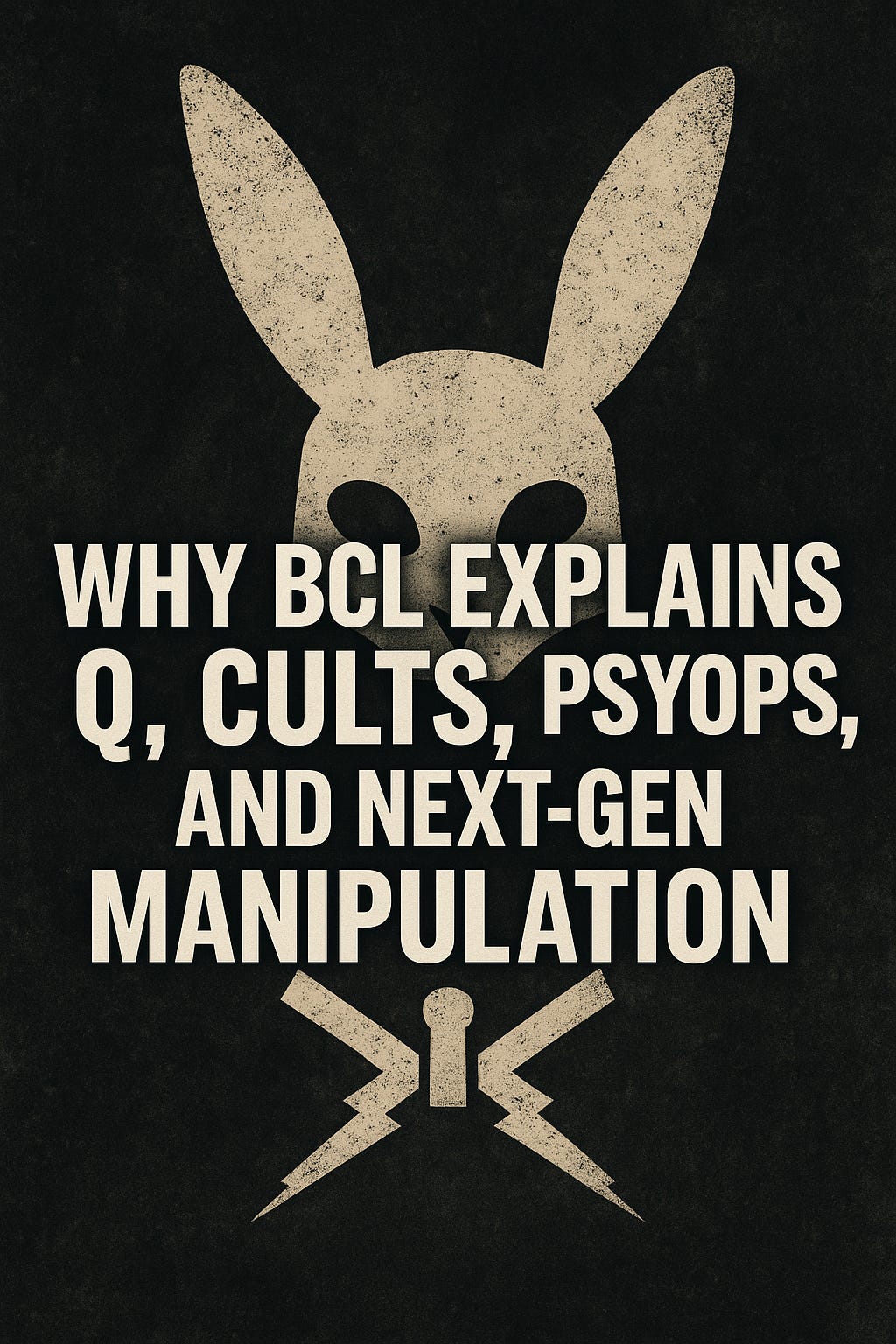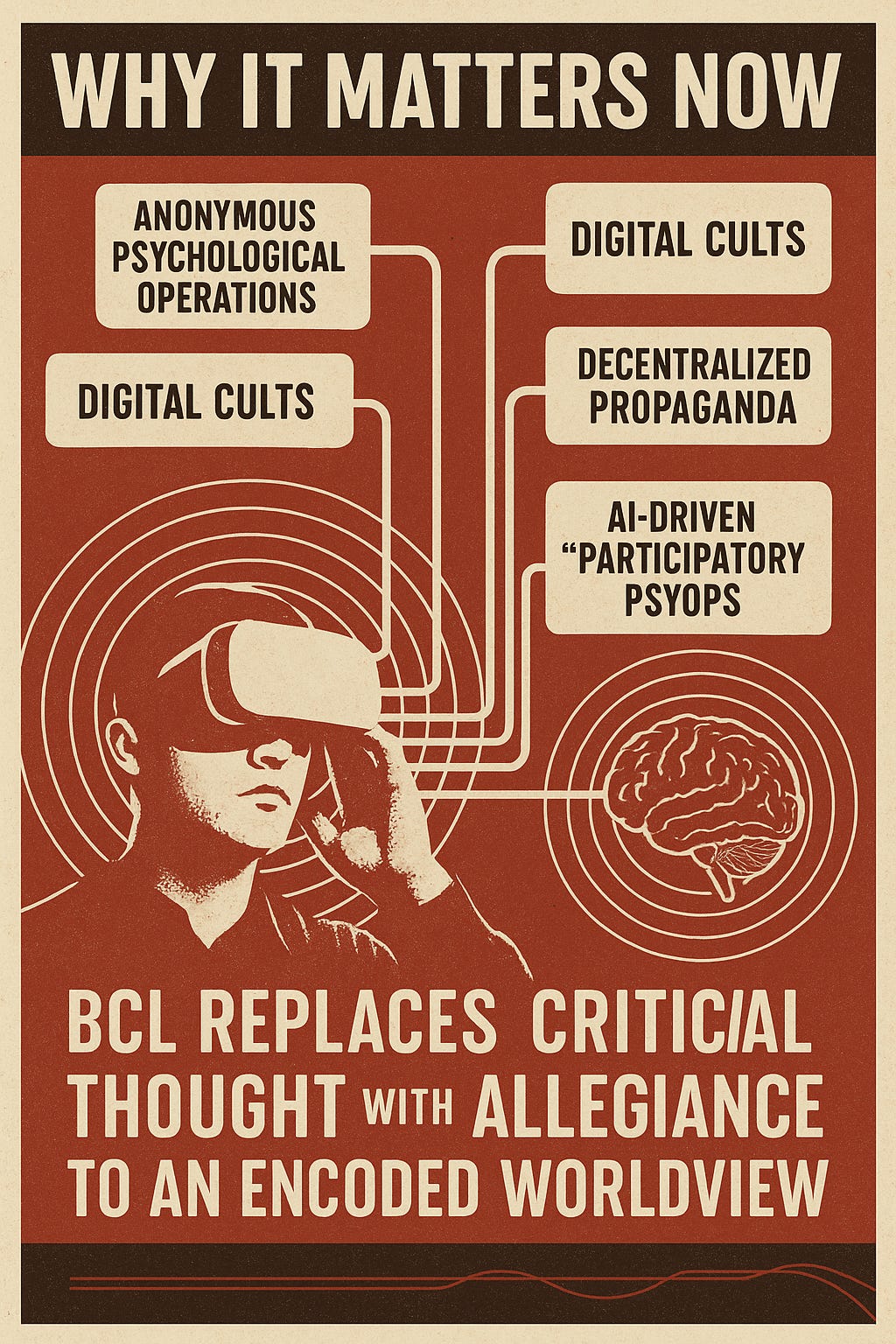Binary Cognitive Locking, Part 2
Why Binary Cognitive Locking Explains Q, Cults, PSYOPs, and Next-Generation Manipulation
No existing framework fully explains the structural mechanics behind modern belief warfare. Cult psychology has long addressed group dynamics and authority obedience. PSYOP doctrine outlines message shaping and behavioral influence. The historical record of MKUltra and other intelligence programs documents trauma-based control, chemical conditioning, and environmental disruption. But none of these models adequately map the binary logic scaffolding that binds these systems into a singular behavioral engine.
Binary Cognitive Locking (BCL) connects those missing links. It is not a replacement for those domains, it is the underlying structure that makes them interoperable.
BCL explains how:
Q-drops fused personal identity with belief by deploying binary emotional triggers.
Cult indoctrination systems train members to reject nuance as betrayal and isolate those who question.
Military-grade psychological operations reduce loyalty to a binary equation: obedience or opposition.
Next-generation influence systems are shifting away from outright falsehoods and toward emotional bifurcation—dividing populations not through facts, but through psychologically enforced allegiance.
This framework was not reverse-engineered from theory. It was identified through forensic pattern recognition. The same linguistic tactics and structural control systems used to radicalize political movements, isolate cult members, and influence civilian populations through digital psyops were also appearing in grooming cycles and child exploitation casework.
What this paper presents is a comprehensive documentation of Binary Cognitive Locking as a unified psychological and operational model. It connects doctrine, survivor reports, grooming cycles, real-time case data, and digital radicalization movements into a single, coherent system of analysis. We are not speculating on what may come—we are describing the battlefield as it already exists.
And crucially, BCL maps directly onto known grooming techniques used by pedophile networks and exploiters. Victim testimony, law enforcement interviews, and psychological profiles describe how abusers enforce emotional binaries to gain trust, break resistance, and suppress escape. They use statements like:
“You either love me or you destroy everything.”
“You’re safe with me. If anyone else finds out, you’ll be hurt.”
“You don’t have to tell anyone. It’s your choice.”
These are not isolated manipulations. They are core operating patterns in the architecture of psychological control. The same binary scaffolding used to silence children and normalize abuse is identical to the emotional logic used to radicalize political followers, indoctrinate cult recruits, and sedate digital populations under the guise of “trusting the plan.” The forensic overlap is not incidental. It is structural.
Definition and Core Hypothesis
Binary Cognitive Locking (BCL) is a psychological control framework that reconfigures how people make decisions, assign identity, and interpret reality. It achieves this by collapsing complexity into emotionally loaded, forced dualities: good versus evil, truth versus lies, patriot versus traitor, us versus them, loyal versus disloyal.
Once these binaries are internalized, they begin to override rational thought. The subject’s ability to think independently is bypassed. Logic is replaced with reflex. Dissent is coded as betrayal. Identity becomes fused with belief. From that point forward, information is no longer evaluated—it is filtered for loyalty.
The result is a closed cognitive loop in which:
Conformity is rewarded
Ambiguity is punished
Emotional consistency is confused with factual truth
This structure is not theoretical. It is operational. BCL was first identified and formally modeled by Project Milk Carton (PMC) during forensic research into child exploitation systems, grooming behaviors, and the symbolic and rhetorical language used by abusers. What began as an effort to understand how predators maintain silence and obedience in children rapidly expanded. The same control patterns were appearing in cultic abuse environments, Q-drops, social media psyops, and digital radicalization networks.
Out of this work, PMC constructed the Binary Cognitive Locking framework as a unified architecture of influence and behavioral control.
The core hypothesis is simple:
The collapse of nuance into binary emotional frames is not accidental, it is a deliberate, repeatable architecture of control.
Whether it’s a predator manipulating a child, a cult leader consolidating authority, a political influencer polarizing an audience, or an algorithm feeding reinforcement loops to the masses, the behavioral pattern is the same. Emotional binaries replace moral complexity. Allegiance becomes identity. Dissent becomes treason. And the subject no longer sees the system for what it is, because they are locked inside of it.
This is why BCL is not constrained by ideology, platform, or age. It can be deployed by individuals, networks, governments, or decentralized AI moderation systems. Its structure is not limited by morality, it is agnostic to its operator. And until now, it did not have a name.
Now it does.
Background and Lineage
Binary Cognitive Locking (BCL) did not emerge in a vacuum. It is the convergence point of multiple disciplines, doctrines, and manipulative systems—all of which utilize binary emotional structures to condition behavior, enforce loyalty, and manipulate perception.
What makes BCL significant is not that it represents a new idea, but that it exposes a shared architecture that has operated across intelligence programs, cult psychology, propaganda campaigns, and predator grooming systems for decades. Project Milk Carton (PMC) uncovered this architecture while conducting forensic investigations into child exploitation, cultic abuse, and mass influence operations. What we found wasn’t theoretical. It was structural. And it was everywhere.
MKUltra and CIA Psychological Conditioning
The roots of BCL can be traced directly to the U.S. intelligence community’s Cold War-era mind control programs, Project MKUltra, Project ARTICHOKE, and a network of subprojects run by the Office of Research and Development (ORD). These operations were not limited to chemical experiments. Declassified documents reveal a sustained effort to explore how binary emotional extremes—pain and pleasure, light and darkness, isolation and immersion—could fracture identity and create programmable behavioral patterns.
These programs tested:
Forced contradiction in emotional response
Doubling and compartmentalization of identity
Reward/punishment conditioning tied to language and compliance
Controlled dissociation as a tool for obedience
While these programs did not name the system “Binary Cognitive Locking,” the structure is unmistakable. Emotional binaries were used to bypass autonomy and force psychological dependency. The experiments weren’t merely about obedience—they were about restructuring how the mind interprets safety, trust, and reality.
Cult Indoctrination Science
Cult psychology has long acknowledged that black-and-white thinking is essential to totalitarian control. Robert Jay Lifton’s Eight Criteria for Thought Reform outlines how ideological systems demand binary submission. Doubt is reframed as disloyalty. Inquiry is rebranded as sabotage. There is only truth and heresy, and the truth is always defined by the group.
Steven Hassan’s BITE model—Behavior, Information, Thought, and Emotional control—further dissects how cults collapse individual thought into binary allegiance. Cults:
Eliminate ambiguity in favor of moral polarity
Employ loaded language that suppresses reflective thinking
Construct narratives where loyalty to the group = goodness, and disobedience = evil
These concepts were historically applied to religious or political cults. But in the digital age, Q and other decentralized belief systems began to replicate them with algorithmic precision. Through meme repetition, symbolic loops, and drop-based “research” rituals, digital followers were subjected to the same psychological environments that cults used for decades—now scaled across platforms and timelines.
BCL captures this effect as a digitized evolution of classical indoctrination, where belief is gamified and identity becomes indistinguishable from allegiance.
Military Doctrine
Contemporary military information operations explicitly formalize the techniques that comprise Binary Cognitive Locking. The U.S. Department of Defense’s Joint Publication 3-13.2 and NATO’s AJP-3.10.1 provide doctrinal frameworks for psychological shaping of civilian and adversary populations.
These manuals describe:
Behavioral influence through moral and emotional dominance
Polarized message construction that removes ambiguity from target interpretation
Repetition of dichotomous framing to drive loyalty and reduce mental flexibility
Non-attribution strategies, where the origin of messages is obscured to displace accountability
The goal is to simplify decision-making in the target population, encouraging action or passivity based not on analysis, but on emotional alignment. Again, while these doctrines do not name the tactic “Binary Cognitive Locking,” they describe the same mechanism in precise terms: reduce cognition to binary alignment, elevate trust in unseen authority, and eliminate the space for dissent.
These techniques were once used exclusively in military theaters. Now, they are being used on domestic populations through decentralized psychological operations that resemble warfare in everything but name.
Alternate Reality Games and Participatory Psyops
The final layer of BCL’s lineage comes from the intersection of propaganda, gamification, and narrative warfare. Alternate Reality Games (ARGs), once used in marketing and entertainment—have evolved into powerful tools of participatory manipulation. Instead of issuing direct commands, ARG-style psyops provide cryptic cues, immersive symbolism, and “research prompts” that lead participants toward preloaded ideological conclusions.
Q is the most prominent example of this model. It used:
Drop-based content to control narrative exposure
Symbolic cues like “crumbs,” “maps,” and “keys” to foster ritual decoding
Weaponized ambiguity—nothing was confirmed, everything was implied
Crowd-sourced loyalty, where community participation became identity itself
In this system, participants are not instructed—they are entrained. They are not told what to believe. They are made to feel like they discovered it themselves.
This illusion of agency is central to BCL. It gives the subject a false sense of autonomy while channeling their thought into a controlled binary environment. The end result is indistinguishable from cultic or grooming systems: trust is diverted from the self and placed into the encoded narrative, obedience is emotionalized, and any deviation is seen as betrayal.
Together, these systems, CIA psychological experiments, cult indoctrination, military PSYOP doctrine, and participatory propaganda—form the behavioral infrastructure of Binary Cognitive Locking. The architecture has existed for decades. It has been tested, deployed, and iterated across domains.
Project Milk Carton simply gave it a name.
And by naming it, we made it visible.
Because once you see the structure, it loses its power.




the bunny rabbit made me think of this:
Donnie Darko & The Holy Neurosis?
https://web.archive.org/web/20050209051345/http://metaphilm.com/philm.php?id=10_0_2_0
When I say dog,
I don't mean cat;
Accountability is where IT's at.
;-)